At 5:15 a.m., Della frisks around the kitchen wagging her tail, far more chipper than the rest of the family right now. Ethan has pulled on a hoodie and makes his way downstairs to grab a granola bar “so I don’t get hungry during my workout.” This is not breakfast. It’s hours until breakfast. Ethan alternates between texting a friend to confirm his class schedule for the day, packing equipment into his sports bag and talking with his parents.
The 17-year-old jokes about getting his own car over the summer.
“Ethan fantasizes in the morning,” his father says dryly as he scans the newspaper.
A soft-spoken kid with deep brown eyes, Ethan flashes his dad a smile. “I’m tired,” the boy admits, propping an elbow on the kitchen island.
Ethan Boroson is an honor student and captain of the baseball team, the kind of boy who makes teachers and other students smile on sight. Though often tired, he’s succeeding. But most high school students fare less well, and lack of sleep is one of the reasons. Mary Carskadon, a professor of psychiatry and human behavior at Brown University and director of chronobiology and sleep research at Bradley Hospital, studies sleep in adolescents and has found that many of them “live in a state of jet lag continually.”
The consensus in the field — informed by a large Centers for Disease Control and Prevention survey of American teens — is that adolescents need about nine hours and 15 minutes of sleep a night, but most get less. Teens are caught in a tug of war between their biology and rules and schedules put in place by adults. Biology is losing.
Adults are disinclined to sleep during the day. Teenagers, however, are hard-wired to be night owls. Their circadian rhythms are timed later than those of other age groups and will remain so into their early 20s. When adults who work a typical day shift start winding down in the evening, an adolescent’s energy and alertness are peaking. The average adolescent isn’t ready — or perhaps even able — to go to sleep until 11 p.m. or later.
Hormones play a role. Our brains produce the hormone melatonin as they prepare to sleep. Synthetic forms are sold over the counter as a sleep aid. Carskadon found that melatonin levels in adolescents don’t rise until about 10:30 p.m. Sending your teen to bed at 10 is likely to lead to tossing and turning but not much sleep until the body agrees it is time. If a child who can’t sleep until 11 p.m. needs to rise at 6 a.m. to catch a bus, that provides just seven hours of sleep — two hours less than the average adolescent needs.
Changing School Start Times Causes Alarm
If, as the science says, teens are more alert and healthier when they sleep later, why haven’t more high schools adjusted their start times? The answer to that question lies in a mix of logistics and politics. See Colleen Shaddox’s story titled “Delaying School Start Times Causes Alarm” on Miller-McCune.com.
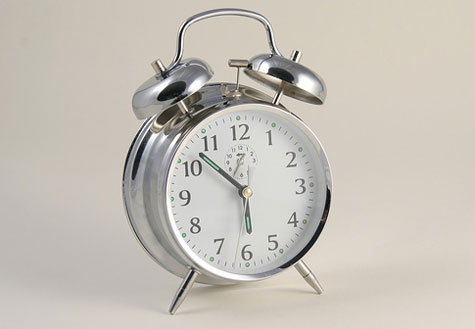
Furthermore, melatonin secretion is still high in adolescents in the early morning hours. During these hours, teens may be in the “rapid eye movement” phase, a period characterized by a high-quality form of sleep that the mind and body need to be fully refreshed. Many parents can testify to just how difficult it is to rouse a sleeping teenager.
Typical high schools in the United States open at about 7:30 a.m. But some communities have adjusted school start times in an effort to synch high school students’ schedules to their body clocks, and the quantitative results have been largely positive, including better attendance and reduced traffic accidents. There is also anecdotal testimony from teachers and parents that better-rested teens are more cheerful and cooperative teens. The change comes with logistical challenges, though. As school districts around the country debate later start times, meetings tend to get heated.
5:45 a.m. Ethan’s school, Cheshire Academy, is about a half-hour from his home in New Haven, Conn. Some mornings, Ethan drives himself; on others, his parents drive, allowing him to catch a nap. This morning, a doe sprints across Whitney Avenue. “Wow,” Ethan says. “I’ve never seen that before.” During the height of the day, Whitney is busy, but at this hour, only the car Ethan is riding in needs to brake for the deer.
On the drive, he talks, as usual, about baseball. Ethan is the second baseman for Cheshire Academy’s Fighting Cats. According to his coach, Ethan would take practice swings in the batting cage all night if allowed. As it is, Ethan spends his Sunday — the only day he doesn’t have other commitments — working out with a private hitting coach. “I want to play ball in college,” Ethan explains. “I need to get strong for that.” He’s on his way to a before-school conditioning program where he’s trying to bulk up with weightlifting and other exercises.
He does this four days a week. On the fifth day, a cardio workout is scheduled, but Ethan skips it. “I need to gain weight,” says the wiry infielder. On cardio mornings, Ethan gets to sleep late — waking at 6:10 a.m. to catch a 7:15 a.m. bus.
Carskadon describes interviewing adolescents about sleep habits and being amazed. “They use magical thinking because that’s all they have,” she says. “They have no science.” One boy told her that he alternates sleeping for 20 minutes and studying for 20 minutes to get through his homework. “That was just not going to help him study or sleep,” she says.
Learning more about sleep would ultimately, she believes, lead us all to an inescapable conclusion: “Sleep is brain food. You cannot replace it with anything else.”
Carskadon says teens become masters of grabbing sleep when they can. Ethan’s friends talk about using free periods for napping in their own cars or in the dorm rooms of friends who board at the school. They are all forever playing catch-up with their sleep deficits — but they never really do seem to catch up.
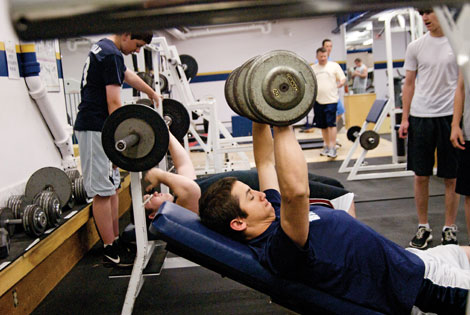
6:30 a.m.Metallica’s “Enter Sandman” is blasting on the boombox as Ethan walks into the weight room. High-decibel metal alternates with high decibel hip-hop as teen boys take turns doing curls, jumping onto platforms while holding medicine balls and lifting bar weights. Varsity baseball coach Daniel O’Dea makes the rounds as they progress through the stations and offers tips about keeping knees bent, backs straight. Sweat and Axe Body Spray compete for odor dominance. This goes on for about 45 minutes until O’Dea shuts off the music and calls the boys into the center of the room. He tells them that their consistency in showing up for these early morning sessions, which are not mandatory, is the key to getting results. They form a circle, put their hands in and shout together, “Hard work!”
It’s the middle of the NBA playoffs, and the Boston Celtics are coming on strong, so there are a lot of late nights for area students. It’s best not to mention staying up past midnight for a West Coast game in Mary Carskadon’s earshot, though — especially if you follow up with an observation that you can get by on only a few hours’ sleep a night.
“I don’t want to hear that,” insists the sleep researcher, who likens it to boasting about a vitamin deficiency. Sleep is a need, she says, not a luxury. Sleep deprivation is linked to poor memory and decreased alertness. Lack of REM sleep has also been shown to cause information processing and memory problems. So when high school students start classes bright and early, just how much are they actually learning?
7:30 a.m. Ethan sits at a crowded table and puts down his tray, which holds at least two breakfasts — pancakes, eggs and toast, and a line of orange juices. Now in his fresh-pressed shirt and tie, he stabs a pancake with his fork and eats it like a Popsicle.
He’s worked hard already, and the day hasn’t really started yet. The boys huddle around one student who’s playing a clip of Conan O’Brien on his smart phone. They laugh and check homework until 8 a.m., when it’s time to head to class.
Ethan walks across the school’s campus, which looks like a miniature college, with rolling expanses of green dotted with red-brick buildings. He walks inside the humanities building. A few classmates are lined up by the door of their American Studies class.
“You think pop quiz today?” a girl asks anxiously.
Ethan grimaces.
The teacher arrives and announces that he has laryngitis. So instead of a lecture, the class will be watching a video.
“Yes!” exclaim several students in unison.
It’s an episode of the television show Boston Legal that touches on censorship, privacy and the right to die. They’ll be discussing it, or trying to, when the class meets next. Once the shades go down in the room, eyelids begin drooping. Ethan’s head rests on his notebook for a moment before he catches himself and sits upright.
Sleepiness can be measured. The Multiple Sleep Latency Test is the standard, and Carskadon has administered the test to thousands of adolescents, many of whom volunteer for overnight studies at her sleep research center. Carskadon studied a group of middle schoolers who started the day at 8:25 a.m., and then re-evaluated them a year later when they were due in high school for a 7:20 a.m. bell. They scored higher on the latency test in high school. In other words, they were more prone to simply fall asleep during the day.
At Cheshire Academy, as at many schools, a rotating schedule means that no course gets stuck in first period five days a week. It’s an acknowledgment by educators that first period is not the ideal time for teaching or learning.
9:10 a.m. Ethan’s pre-calculus class is moving fast. The teacher is working through the process of determining the area under a curve. “Do you agree?” he asks his nine students at almost every stage of the calculations. They call out figures and questions. They seem tremendously engaged, even though there’s a fair bit of yawning.
Minneapolis is a rich source of data on the difference schedules make in teen health and achievement. The city moved its high school starts forward from 7:15 a.m. to 8:40 a.m. during the 1997-98 school year. Scientists at the University of Minnesota did extensive research on the effects. Scientists asked students about feelings and behaviors associated with depression, such as being too tired to do things or feeling hopeless about the future. Minneapolis students reported fewer of these depressive signs than peers with earlier start times.
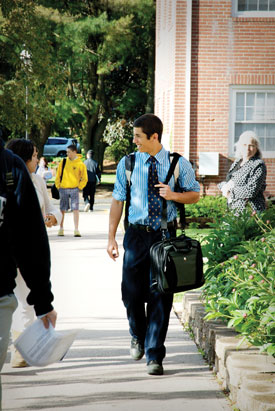
Attendance improved overall. More students stayed enrolled in the same high school after the hours change — a factor associated with higher graduation rates and better test scores. This may be a consequence of the district’s attendance policy; students with eight unexcused absences or tardies in a semester were automatically dropped from the class or classes they were missing. Students on the verge of having eight strikes would routinely transfer to other schools. “At times, there have been so many students shuffling from school to school that the transferred transcripts could not keep up with all the moves,” writes Kyla Wahlstrom of the Center for Applied Research and Educational Improvement at the University of Minnesota in an analysis of the schedule change. “Having a later start for the first hour of class appears to enable more students to not oversleep and to arrive at school on time.”
There was a slight uptick in grades, but it was not statistically significant. Participation in sports and other extracurricular activities stayed the same, even though those activities were starting later. Principals reported fewer disciplinary problems, and nurses and counselors saw a reduction in students seeking help with relationship difficulties involving peers or parents. Though suburban parents were generally more supportive of the change than urban parents, both groups noted their children were “easier to live with.”
In Minneapolis, as elsewhere, there was fear that high schoolers with a later start time would simply stay up later at night. In fact, a 10:45 p.m. bedtime was typical before and after the change. But most students slept an hour later in the morning after the schedule change, thus picking up five more hours of sleep a week.
11 a.m. “This is my one free period where I don’t have any friends, so I get a lot of work done,” Ethan says as he walks into school library, where the only sound is the white noise of the copy machine. He finds himself a terminal at the back wall and begins searching the Internet for pictures of Roberto Clemente. He’s doing a PowerPoint presentation on the ballplayer for Spanish class.
The quiet is broken when two students in conversation descend the stairs.
“I have my … tutor tonight at 4. So I have to floor it to Hamden,” says one girl as she rushes on her way.
Ethan’s just come from Spanish class, where the students were highly impressed by Ms. Alexandro’s ability to catch a student texting under his desk, pocket the offending cell phone and continue on with her teaching without missing a beat. Technology competes for kids’ attention every minute of the day. A week earlier, Cheshire had a power outage. Teachers talk about this almost nostalgically. No Facebook, no videos. It was easy to get the boarding students to bed on time.
Children have defied bedtimes since the invention of the flashlight and the comic book, but Carskadon believes that the interactive technologies available to kids now may be more stimulating. Computer and video games, for example, can increase levels of dopamine, a brain chemical that plays a critical role in regulating sleep.
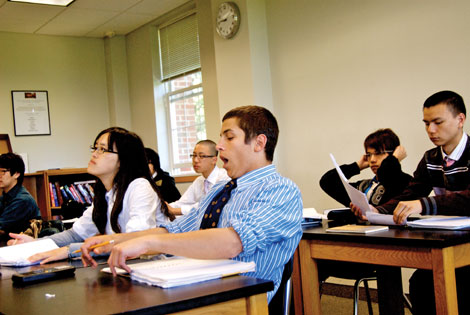
Carskadon says she’d like to be able to wave a magic wand and shut down the Internet every night. Cheshire Academy does shut down Internet service in the dorms after bedtime. A lower-tech solution, Carskadon suggests, is having a family cell phone box into which every member drops his or her phone in the evening.
Noon. “I go to bed at 8:45,” declares Beck Bond, a 17-year-old junior. His lunch table erupts in skeptical laughter. “That’s like when I get home,” says one boy. “I’ve talked with you on Facebook later than that,” Ethan insists. Beck reconsiders. He stays up later when Lost is on — and maybe a few other shows. “I’m not a night owl,” he maintains.
Between tossing straw wrappers and insults at each other, these young men are organizing their busy lives. A teacher comes by to tell Beck that the tennis team will be in an All-New England tournament. They’re working out travel arrangements for the Saturday match.
“Beck’s never won a game,” Ethan says. (Later, when Beck is out of earshot, Ethan makes sure I know that his friend is one of the top-ranked players in the state.) Beck grabs his heart like a silent movie actor and predicts that Ethan will win the baseball Coach’s Award, a recognition more of sportsmanship than talent. “He might not be the tallest, but he has the biggest heart on the team,” he says, wiping away a stage tear.
Ethan passes around a petition to get himself on the ballot for class vice president. Other kids come by, collecting pledges for a breast cancer fundraiser. The cafeteria is awash in signup sheets.
Part-time employment seems to be a culprit in sleep deprivation; research has shown that students who put in more hours on the job get less sleep than their peers. There are also after-school activities. Ethan is constantly discussing scheduling issues with his friends. Most of the discussion is about things the students choose, but are not required, to do.
Remember, though: This is a prep school, and these days, college-bound students need to be involved in extra-curricular activities. Consultant Katherine Cohen runs a firm, IvyWise, that helps students prepare to apply for college. Admissions officers want to see that a student has had an impact on his or her high school or community, Cohen says. There’s no “magic number” of activities, she says; the important thing is to exhibit commitment and leadership. “It’s rarely just one,” she adds, “unless you’re a star in that one activity.”
1:30 p.m. Students are dreading social studies. It’s taught in lecture format, and it’s right after lunch — a double whammy to their ability to stay alert. They file in around a boardroom-style table. Some are still finishing dessert. “Pop quiz?” one asks shyly.
This time there’s no reprieve. The teacher asks them to put away their books and take out a piece of paper.
“What caused the Cold War?” he asks.
Ethan’s schedule isn’t typical. He goes to a private school, and his devotion to athletics makes his days especially full. We approached two different public school districts where students volunteered to participate in the story, but in both cases administrators would not let Miller-McCune spend the day with a student because we would “disrupt the educational process.” Cheshire Academy Headmaster Doug Rogers quickly gave us permission to report on campus because of his interest in sleep science.
Beginning in the 2010-11 school year, Cheshire Academy will move its start time forward a half-hour, making the first class 8:30 a.m., about an hour later than most public schools in the area. Cheshire will accommodate later start times by shortening the day slightly and extending the school year by four days. No academic time will be lost. Athletic practices will be cut by only 15 minutes per week. Rogers is hopeful that better-rested athletes will have an edge.
Many prep schools are embracing later start times in response to adolescent sleep research. Those that have already made the change are seeing persuasive results. St. George’s School in Rhode Island, for example, did a nine-week trial, moving its start time forward to 8:30 a.m. During that period, fewer students reported daytime sleepiness. Tardiness, dorm infractions and other disciplinary measures dropped. St. George’s decided to make the schedule change permanent.
Cheshire had a brief flirtation with the new schedule when cases of H1N1 flu began to show up in Connecticut during the winter of 2009-10. Rogers temporarily instituted a later start time during the height of the flu season. “We got healthier faster,” Rogers said. His rationale for the change is that later start times support academics and health, and he plans to track indicators to measure changes in both areas. He also foresees an intangible benefit. “If you’re better rested, you can summon a little generosity of spirit,” the headmaster says.
3:30 p.m. It’s transition time. Ethan and his friends shoot hoops in the gym. There’s only one girl among the players, but others keep drifting in to make small talk with the boys, who generally seem more interested in jump shots. One girl is upset with Beck about a misinterpreted text message. He just keeps shooting baskets.
“Do you have a lacrosse game today?” he asks.
“No, I have one tomorrow, if you would like to attend,” she says, with mock formality.
Changing its schedule was relatively easy for Cheshire Academy, which has no elementary program and doesn’t need to consider town politics in decision-making. For public schools, the process is rockier. Bus schedules are often a major sticking point. Transpar Group, a consultancy that helps districts reconfigure bus patterns to cut costs, often hears from districts interested in moving high school start times. But most decide in the end not to do it, according to the group’s chief financial officer, Jeff McHenry.
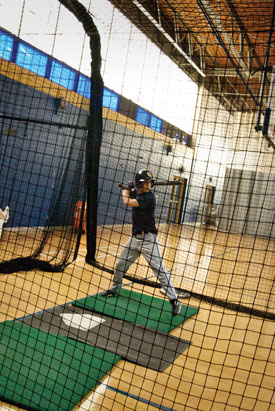
4 p.m. Baseball practice is lightly attended because many of the players are at a junior varsity game. Ethan spends time hitting off a tee and later in a cage. His brother, Zach, a college student and Cheshire Academy alum, is in the gym helping a player with his throwing form. Zach will drive Ethan home, where physics, Spanish and English homework await the younger brother.
A North Carolina study found that drivers under the age of 25 cause more than half of all traffic accidents that involve falling asleep at the wheel. States deal with the safety issues raised by teens who drive in a variety of ways, including increases in the legal driving age or limits on the circumstances in which teens can drive (for example, only in the daytime).
Fred Danner and Barbara Phillips, a psychologist and a medical doctor, respectively, at the University of Kentucky, compared students in Fayette County, which had moved its high school start time to 8:30 a.m., with their peers across Kentucky, who generally went to school earlier. Car crashes involving high school-aged drivers in Fayette County went down 16.5 percent in a period when accidents among that age group statewide rose by 7.8 percent.
5:15 p.m. Linda Goodman, Ethan’s mother, is preparing a yam-and-chicken casserole while he snacks on Fruit Loops. He’s going to relax until dinner, then tackle that homework. So when does Ethan just socialize? “I went to the movies Friday night,” he says, adding that Sundays are often a good time to get together with friends.
He’s got an upcoming birthday party. A freshman approached him today fishing for an invitation. Ethan smiled at the younger student indulgently, “You can come, sure,” he said.
“OK, but I’m not driving yet. How will I get there?” the would-be partygoer asked.
“I don’t know,” said Ethan, who drew the line at providing taxi service to underclassmen. “But if you get a ride, you can certainly come.”
Ethan does not work during the school year, but will have a part-time job at his father’s architectural firm this summer. His baseball schedule is intense over the summer, as well, when he plays with a competitive Amateur Athletic Union team.
Sleep deprivation is part of military training, because combat requires functioning with little or no sleep. But several branches have taken a hard look at adolescent sleep research, given that most recruits are young adults and likely to have later-phased sleep patterns. Research conducted at the United States Navy’s Recruit Training Command at Great Lakes, Ill., convinced the Navy to give trainees more shut-eye. Recruits went from a six-hour sleep schedule to eight hours. Under the eight-hour regimen, standardized test scores improved 11 percent.
9 p.m. After some computer and television time, Ethan digs into his physics homework. It’s a light night, about an hour’s work, because he’s gotten a lot done during his free period.
Do years of inadequate sleep have a long-term consequence? “We don’t know for sure,” Carskadon says. She points to adult diseases that experts know are linked to sleep, such as depression and obesity. The research simply does not exist to determine if poor sleep in adolescence plays a role here.
10:30 p.m. Ethan calls it a night and heads upstairs to bed. “Sometimes I’ll be on Facebook or just talking to people for like a little bit,” he says. Tonight he forgoes both. It takes him about a half-hour to go to sleep. Tomorrow morning, he’ll start all over again at 5 a.m.




